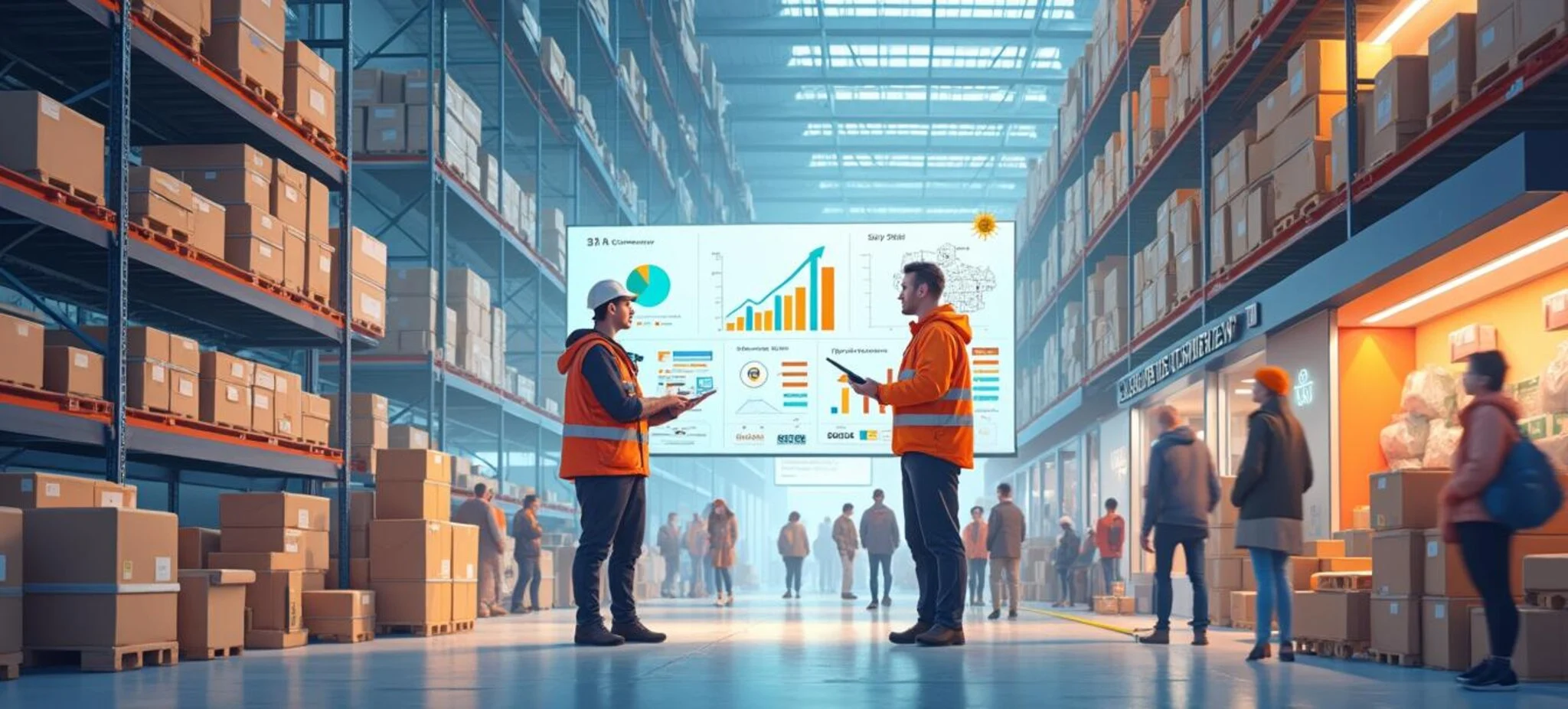Has Polish E-Commerce Really Slowed Down? Analysis, Data, and Development Trends
Published: August 27, 2025 | Last updated: August 27, 2025
The share of online sales in total retail sales in Poland has been declining for several months. Is this a sign of stagnation in the e-commerce sector, or merely an apparent drop heralding deeper changes? The answer is: e-commerce hasn't slowed down – it's transforming. The digitization of commerce is entering a new phase, and the pace of change now depends on the quality of shopping experiences, personalization, and logistics efficiency.
Small and medium-sized e-retailers (SMEs) shouldn't panic. A drop in share is not the same as a drop in revenue – on the contrary, online commerce is still growing in volume; it's just that its role in the channel mix is shifting. In this article, we show how to interpret these trends and how to leverage upcoming changes to grow your own store.
Table of Contents
- What GUS Says: E-commerce Share Drops, But Sales Grow
- Is It Really a “Ceiling”? How to Interpret the Data
- New Growth Directions: From Textiles to Auto Parts
- What Influences Changing Consumer Behavior?
- SME Strategies: How to React to Decreasing E-commerce Share
- Convenient Payment Handling? Check Out Payment Solutions
- Online Commerce – Frequently Asked Questions (FAQ)
- Online Shopping: Key Takeaways
— Despite the percentage drop, e-commerce sales in Poland continue to grow nominally.
— The “online auto parts” category is booming (+400% y/y), signaling new trust in e-commerce.
— E-sellers should focus on service quality, logistics optimization, and expanding product categories.
— Commerce digitization is not slowing down – it's just changing its growth trajectory.
What GUS Says: E-commerce Share Drops, But Sales Grow
According to GUS data from July 2025, online sales accounted for 8.6% of total retail sales in Poland, representing a 0.2 p.p. decrease compared to the same month a year earlier. This marks the eighth consecutive month of a consistent drop in e-commerce share within the retail channel mix.
However, it is worth noting that the nominal value of online sales increased:
- +2.5% y/y
- +2.9% m/m
This means that e-commerce is still growing, but at a slower pace than offline retail or other growing retail categories. As a result, the relative share of the online channel decreases. But this does not indicate sector stagnation – on the contrary, it may reflect a generational shift or a move toward an omnichannel model.
Why Is the Percentage Share Dropping?
The growth in offline sales value is partly due to seasonal promotions, post-pandemic recovery, and strong inflationary impacts. When the offline basket grows faster than online, the e-commerce share drops – even if its absolute value continues to rise.
Is It Really a “Ceiling”? How to Interpret the Data
No, e-commerce in Poland has not hit the ceiling. A decline in share does not mean the market has halted – it means its growth dynamics are changing. So far, e-commerce has expanded mainly due to a rapid influx of new customers (e.g., during the COVID-19 pandemic). Now, its growth depends on:
- increased average basket value
- penetrating more advanced categories (e.g., electronics, consumer appliances, automotive)
- better customer service and UX
Miłosz Mickiewicz, Sales and Business Development Director at Comperia.pl, points out that “real growth will no longer be visible in percentage share alone, but in the strength of customer relationships.”
New Growth Directions: From Textiles to Auto Parts
GUS reports that the e-commerce share within the “textiles, clothing, footwear” group rose to 23.4%, confirming this category’s solid position in the online channel. Interestingly, the automotive and auto parts category recorded spectacular growth:
- +400% y/y in online sales
- e-commerce share in this category increased to 4.0%
This marks a significant leap compared to previous years, where this figure rarely exceeded 1%. This demonstrates that consumer trust in buying online has grown significantly – even in traditionally difficult categories like automotive.
The “online auto parts” trend signals that digitization has entered very “analog” industries. Users are more willing to use the internet even for decisions requiring technical knowledge.
What Influences Changing Consumer Behavior?
The drop in percentage share is not necessarily negative – it means that e-commerce must now compete "deeper" rather than just "wider." Consumers are becoming:
- more demanding in terms of customer service
- increasingly focused on product quality and post-sale services
- less sensitive to traditional discount campaigns
- oriented toward personalization and fast delivery
Important Shopping Trends in Poland and Europe:
- Growing significance of AI (e.g., shopping agents)
- Omnichannel and click & collect becoming standard
- Eco-consciousness and sustainable logistics as decisive factors
SME Strategies: How to React to Decreasing E-commerce Share
For small and medium e-retailers, this means one thing: it’s time to improve quality rather than just lowering prices. Here are several actionable directions aligned with current trends:
1. Focus on Customer Experience
- Speed up site loading and develop a mobile version
- Add real-time shipment tracking
- Provide 24/7 customer support (chatbots, email support)
2. Expand the Offer with Premium or Higher-Margin Products
If basket quantity isn't growing, quality must. Consumers are willing to pay more for convenience, speed, and quality.
3. Build Loyalty Instead of Just Promoting
Implement loyalty programs, subscription options, or AI-based recommendations. Repeat purchases bring tangible value.
4. Explore New Product Categories
Consider categories such as auto parts, SaaS software, medical apparel, home office gear, and hobby products.
Want convenient payment handling? Check out payment solutions from Przelewy24
Online Commerce – Frequently Asked Questions (FAQ)
1. Why is the e-commerce share in retail sales decreasing?
Because offline sales value is growing faster. Yet online sales still grow nominally, meaning the industry continues to develop.
2. Does this mean the end of e-commerce growth?
No. It means the nature of growth is changing – from quantity to quality.
3. Which product categories are growing the fastest?
Online auto parts, apparel, consumer electronics, eco-friendly products, and health-related goods.
4. What should a small e-store do in this situation?
Improve the customer journey, offer convenient payments and fast delivery, enter marketplaces, and export.
5. Will AI agents change e-commerce?
Yes, shopping AI tools are already transforming the sector – offer personalization, marketing automation, and product recommendations are becoming standard.
Online Shopping: Key Takeaways
E-commerce hasn't hit a “ceiling.” GUS data shows a declining percentage share in retail sales, but nominal sales are up. This shift signals new consumer behavior dynamics and market maturity. New segments – like online auto parts – are growing rapidly, and digital experiences are becoming the main competitive battleground.
Retailers should focus on service quality, UX development, and shopping convenience, building growth on proven technologies, payment systems, and customer loyalty.
Convenient payment methods for your customers are an opportunity to grow your business.
Sources:
- GUS: Retail Sales in July 2025 – https://ssgk.stat.gov.pl
- Comperia.pl – Expert commentary by Miłosz Mickiewicz
- Nowymarketing.pl: AI Shopping Agents as Game-Changers in E-commerce – https://nowymarketing.pl
- Eurostat: Digital Economy and Society Statistics



